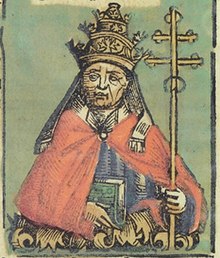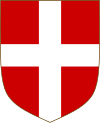Amadeus VIII, Duke of Savoy
Felix V | |
|---|---|
 Antipope Felix V, the last historical Antipope. | |
| Papacy began | 5 November 1439 |
| Papacy ended | 7 April 1449 |
| Opposed to | Eugene IV and Nicholas V |
| Personal details | |
| Birth name | Amadeus VIII |
| Born | 4 September 1383 Chambéry |
| Died | 7 January 1451(1451-01-07) (aged 67) |
| Parents | Amadeus VII, Count of Savoy and Bonne of Berry |
| Coat of arms | |
| Other popes and antipopes named Felix | |
Amadeus VIII (4 September 1383 – 7 January 1451) was a Savoyard nobleman, the son of Amadeus VII, Count of Savoy and Bonne of Berry. He was surnamed the Peaceful. After the death of his father in 1391, his mother acted as a regent, because of his youth. He was an antipope of the Catholic Church from 1439 to 1449 as Felix V, in opposition to Popes Eugene IV and Nicholas V.
Contents
1 Life
2 Election as anti-pope
3 Family
4 Ancestors
5 See also
6 References
7 Sources
8 External links
Life
Born at Chambéry, he was the Count of Savoy from 1391 to 1416 and was elevated by Emperor Sigismund to Duke of Savoy in 1416.
In 1418 his distant cousin Louis of Piedmont, his brother-in-law, the last male of the elder branch of House of Savoy, died, leaving Amadeus as his heir-general, thus finally uniting the male-lines of the House of Savoy.
Election as anti-pope
Amadeus increased his dominions and encouraged several attempts to negotiate an end to the Hundred Years' War. After the death of his wife, he founded the Order of Saint Maurice with six other knights (1434).[1] They lived alone in the castle of Ripaille, near Geneva, in a quasi-monastic state. Amadeus was elected at Basel as pope Felix V in opposition to Pope Eugene IV, by the Council of Basel-Ferrara-Florence and reigned from November 1439 to April 1449.[2] He resigned as duke in favour of his son in 1440. He stepped down to accept a Cardinal's hat.
Amadeus' image in history is marred by the account of him as a pontiff concerned with money, to avoid disadvantaging his heirs, found in the Commentaries of Pius II. Nor is there evidence that he intrigued to obtain the papal office, sending the bishops of Savoy to Basel for this purpose.
(Note on numbering: When numbering of the Popes began to be used, Antipope Felix II was counted as one of the Popes of that name. The second true Pope Felix is thus known by the number III, and the third true Pope Felix was given the number IV. It also affected the name taken by Amadeus, who would have been the fourth Pope Felix.)

Coat of arms of Savoy
Family
He married Mary of Burgundy (1386–1422), daughter of Philip the Bold,[3]Duke of Burgundy and granddaughter of John II of France. They had nine children:
- Margaret of Savoy (13 May 1405 – 1418).
- Anthony of Savoy (September 1407 – bef. 12 December 1407).
- Anthony of Savoy (1408 – aft. 10 October 1408).
Marie of Savoy (end January 1411 – 22 February 1469), married Filippo Maria Visconti, duke of Milan.[4]
- Amadeus of Savoy (26 Mar 1412 – 17 August 1431), Prince of Piemonte.
Louis of Savoy (24 February 1413 – 29 January 1465), his successor.- Bonne of Savoy (September 1415 – 25 September 1430).
- Philip of Savoy (1417 – 3 March 1444), Count of Genève.
Margaret of Savoy (7 August 1420 – 30 September 1479), married firstly Louis III, titular king of Naples,[5] secondly Louis IV, Count Palatine of the Rhine[6] and thirdly Ulrich V, Count of Württemberg.
Ancestors
.mw-parser-output table.ahnentafel{border-collapse:separate;border-spacing:0;line-height:130%}.mw-parser-output .ahnentafel tr{text-align:center}.mw-parser-output .ahnentafel-t{border-top:#000 solid 1px;border-left:#000 solid 1px}.mw-parser-output .ahnentafel-b{border-bottom:#000 solid 1px;border-left:#000 solid 1px}
| Ancestors of Amadeus VIII, Duke of Savoy | ||||||||||||||||||||||||||||||||||||||||||||||||||||||||||||||||||||||||||||||||||||||||||||||||||||||||||||||||||||||||||||||||||||||||||||||||||||||||||||||||||||||||||||||||||||||||||||||||||||||||||||||||||||||||||||||||||||||||||||||||||||||||||||||||||||||||||||||||||||||||||||||||||||||||||||||||||||||||||||||||||||||||||||||||||||||||||||||||||||||||||||||||||||||||||||||||||||||||||||||||||||||||||||||||||||||||||||||||||||||||||||||||||||||||||||||||||||||||||||||||||||||||||||||||||||||||||||||||||||||||||||||||||||||||||||||||||||||||||||||||||||||||||||||||||||||||||||||||
|---|---|---|---|---|---|---|---|---|---|---|---|---|---|---|---|---|---|---|---|---|---|---|---|---|---|---|---|---|---|---|---|---|---|---|---|---|---|---|---|---|---|---|---|---|---|---|---|---|---|---|---|---|---|---|---|---|---|---|---|---|---|---|---|---|---|---|---|---|---|---|---|---|---|---|---|---|---|---|---|---|---|---|---|---|---|---|---|---|---|---|---|---|---|---|---|---|---|---|---|---|---|---|---|---|---|---|---|---|---|---|---|---|---|---|---|---|---|---|---|---|---|---|---|---|---|---|---|---|---|---|---|---|---|---|---|---|---|---|---|---|---|---|---|---|---|---|---|---|---|---|---|---|---|---|---|---|---|---|---|---|---|---|---|---|---|---|---|---|---|---|---|---|---|---|---|---|---|---|---|---|---|---|---|---|---|---|---|---|---|---|---|---|---|---|---|---|---|---|---|---|---|---|---|---|---|---|---|---|---|---|---|---|---|---|---|---|---|---|---|---|---|---|---|---|---|---|---|---|---|---|---|---|---|---|---|---|---|---|---|---|---|---|---|---|---|---|---|---|---|---|---|---|---|---|---|---|---|---|---|---|---|---|---|---|---|---|---|---|---|---|---|---|---|---|---|---|---|---|---|---|---|---|---|---|---|---|---|---|---|---|---|---|---|---|---|---|---|---|---|---|---|---|---|---|---|---|---|---|---|---|---|---|---|---|---|---|---|---|---|---|---|---|---|---|---|---|---|---|---|---|---|---|---|---|---|---|---|---|---|---|---|---|---|---|---|---|---|---|---|---|---|---|---|---|---|---|---|---|---|---|---|---|---|---|---|---|---|---|---|---|---|---|---|---|---|---|---|---|---|---|---|---|---|---|---|---|---|---|---|---|---|---|---|---|---|---|---|---|---|---|---|---|---|---|---|---|---|---|---|---|---|---|---|---|---|---|---|---|---|---|---|---|---|---|---|---|---|---|---|---|---|---|---|---|---|---|---|---|---|---|---|---|---|---|---|---|---|---|---|---|---|---|---|---|---|---|---|---|---|---|---|---|---|---|---|---|---|---|---|---|---|---|---|---|---|---|---|---|---|---|---|---|---|---|---|---|---|---|---|---|---|---|---|---|---|---|---|---|---|---|---|---|---|---|---|---|---|---|---|---|---|---|---|---|---|---|---|---|---|---|---|---|---|---|---|---|---|---|---|---|---|---|---|---|---|---|---|---|---|---|---|---|---|---|---|---|---|---|---|---|---|---|---|---|---|---|---|---|---|---|---|---|---|---|---|---|---|---|---|---|---|---|---|---|---|---|---|---|---|---|---|---|---|---|---|---|---|---|---|---|---|---|
| ||||||||||||||||||||||||||||||||||||||||||||||||||||||||||||||||||||||||||||||||||||||||||||||||||||||||||||||||||||||||||||||||||||||||||||||||||||||||||||||||||||||||||||||||||||||||||||||||||||||||||||||||||||||||||||||||||||||||||||||||||||||||||||||||||||||||||||||||||||||||||||||||||||||||||||||||||||||||||||||||||||||||||||||||||||||||||||||||||||||||||||||||||||||||||||||||||||||||||||||||||||||||||||||||||||||||||||||||||||||||||||||||||||||||||||||||||||||||||||||||||||||||||||||||||||||||||||||||||||||||||||||||||||||||||||||||||||||||||||||||||||||||||||||||||||||||||||||||
See also
- Guillaume Huin d'Estaing
- Louis Aleman
- Papal selection before 1059
Papal conclave (since 1274)
Papal styles of Antipope Felix V | |
|---|---|
 | |
| Reference style | His Holiness |
| Spoken style | Your Holiness |
| Religious style | Holy Father |
| Posthumous style | None |
References
^ Pinder 2002, p. 44.
^ Decaluwe, Izbicki & Christianson 2017, p. 443.
^ Vaughan 2005, p. 53.
^ Wilkins & Wilkins 1996, p. 107.
^ Kekewich 2002, p. 54.
^ Kekewich 2008, p. 214.
Sources
- Andenmatten, B.; Paravicini Bagliani, A. (ed.) (1992). Amédée VIII-Félix V, premier duc de Savoie et pape (1383-1451). Colloque international, Ripaille-Lausanne, 23-26 octobre 1990. Lausanne 1992. (in French)
- Bruchet, M. (1907). Le château de Ripaille Paris 1907. See: pp. 49-182. (in French)
- Cognasso, Francesco (1930). Amadeo VIII (1383-1451). 2 vols. Turin, 1930. (in Italian)
Decaluwe, Michiel; Izbicki, Thomas M.; Christianson, Gerald, eds. (2017). A Companion to the Council of Basel. Brill..mw-parser-output cite.citation{font-style:inherit}.mw-parser-output .citation q{quotes:"""""""'""'"}.mw-parser-output .citation .cs1-lock-free a{background:url("//upload.wikimedia.org/wikipedia/commons/thumb/6/65/Lock-green.svg/9px-Lock-green.svg.png")no-repeat;background-position:right .1em center}.mw-parser-output .citation .cs1-lock-limited a,.mw-parser-output .citation .cs1-lock-registration a{background:url("//upload.wikimedia.org/wikipedia/commons/thumb/d/d6/Lock-gray-alt-2.svg/9px-Lock-gray-alt-2.svg.png")no-repeat;background-position:right .1em center}.mw-parser-output .citation .cs1-lock-subscription a{background:url("//upload.wikimedia.org/wikipedia/commons/thumb/a/aa/Lock-red-alt-2.svg/9px-Lock-red-alt-2.svg.png")no-repeat;background-position:right .1em center}.mw-parser-output .cs1-subscription,.mw-parser-output .cs1-registration{color:#555}.mw-parser-output .cs1-subscription span,.mw-parser-output .cs1-registration span{border-bottom:1px dotted;cursor:help}.mw-parser-output .cs1-ws-icon a{background:url("//upload.wikimedia.org/wikipedia/commons/thumb/4/4c/Wikisource-logo.svg/12px-Wikisource-logo.svg.png")no-repeat;background-position:right .1em center}.mw-parser-output code.cs1-code{color:inherit;background:inherit;border:inherit;padding:inherit}.mw-parser-output .cs1-hidden-error{display:none;font-size:100%}.mw-parser-output .cs1-visible-error{font-size:100%}.mw-parser-output .cs1-maint{display:none;color:#33aa33;margin-left:0.3em}.mw-parser-output .cs1-subscription,.mw-parser-output .cs1-registration,.mw-parser-output .cs1-format{font-size:95%}.mw-parser-output .cs1-kern-left,.mw-parser-output .cs1-kern-wl-left{padding-left:0.2em}.mw-parser-output .cs1-kern-right,.mw-parser-output .cs1-kern-wl-right{padding-right:0.2em}
- Hildesheimer, E. (1970). "Le Pape du Concile, Amédée VIII de Savoie," Annales de la Société des Lettres, Sciences et Arts des Alpes-Maritime, 61 (1969-1970), pp. 41-48. (in French)
Kekewich, Margaret L. (2008). The Good King: René of Anjou and Fifteenth Century Europe. Palgrave Macmillan.
Pinder, Kymberly N., ed. (2002). Race-ing Art History: Critical Readings in Race and Art History. Routledge.
Vaughan, Richard (2005). Philip the Bold: The Formation of the Burgundian State. Boydell Press.
Wilkins, David G.; Wilkins, Rebecca L. (1996). The Search for a Patron in the Middle Ages and the Renaissance. E. Mellen Press.
External links
- Cognasso, Francesco (2000). "FELICE V, antipapa". Enciclopedia dei Papi (Treccani 2000) (in Italian)
- Catholic Encyclopedia entry
Wikisource has original works written by or about: Felix V |
- Bernard Andenmatten: Felix V. in German, French and Italian in the online Historical Dictionary of Switzerland.
Amadeus VIII the Peaceful House of Savoy Born: 4 September 1383 Died: 7 January 1451 | ||
| Regnal titles | ||
|---|---|---|
New creation County elevated to Duchy | Duke of Savoy 1416–1440 | Succeeded by Louis, Duke of Savoy |
| Preceded by Amadeus VII | Count of Savoy 1391–1416 | County elevated to Duchy |
.mw-parser-output .subjectbar{background-color:#f9f9f9;border:1px solid #aaa;clear:both;margin-bottom:0.5em;margin-top:0.5em;width:100%;box-sizing:border-box;font-size:88%}
